The Impact of Inter-Modulation Components on Interferometric GNSS-Reflectometry
Abstract
:1. Introduction
2. Characteristics of the Multiplexed Signals
3. Impact on iGNSS-R Altimetric Performance
- -
- Case 1: considering only the ranging components, i.e., the composite of the C/A, P and M codes as in previous studies,
- -
- Case 2: considering the fully composite signal including both the ranging, as well as the extra IM component.
3.1. Waveform Model
3.2. Signal to Thermal Noise Ratio
3.3. Altimetric Sensitivity
3.4. Precision Analysis
4. Conclusions
Acknowledgments
Author Contributions
Conflicts of Interest
References
- Martín-Neira, M. A passive reflectometry and interferometry system (PARIS): Application to ocean altimetry. ESA J. 1993, 17, 331–355. [Google Scholar]
- Lowe, S.T.; Zuffada, C.; Chao, Y.; Kroger, P.; Young, L.E.; LaBrecque, J.L. 5-cm-Precision aircraft ocean altimetry using GPS reflections. Geophys. Res. Lett. 2002, 29. [Google Scholar] [CrossRef]
- Ruffini, G.; Soulat, F.; Caparrini, M.; Germain, O.; Martín-Neira, M. The Eddy Experiment: Accurate GNSS-R ocean altimetry from low altitude aircraft. Geophys. Res. Lett. 2004, 31. [Google Scholar] [CrossRef]
- Rius, A.; Cardellach, E.; Martin-Neira, M. Altimetric analysis of the sea-surface GPS-reflected signals. IEEE Trans. Geosci. Remote Sens. 2010, 48, 2119–2127. [Google Scholar] [CrossRef]
- Ghavidel, A.; Camps, A. Time-domain statistics of the electromagnetic bias in GNSS-reflectometry. Remote Sens. 2015, 7, 11151–11162. [Google Scholar] [CrossRef] [Green Version]
- Carreno-Luengo, H.; Camps, A. Empirical results of a surface-level GNSS-R experiment in a wave channel. Remote Sens. 2015, 7, 7471–7493. [Google Scholar] [CrossRef] [Green Version]
- Mashburn, J.; Axelrad, P.; Lowe, S.T.; Larson, K.M. An assessment of the precision and accuracy of altimetry retrievals for a Monterey Bay GNSS-R experiment. IEEE J. Sel. Top. Appl. Earth Obs. Remote Sens 2016, 9, 4660–4668. [Google Scholar] [CrossRef]
- Clarizia, M.P.; Ruf, C.; Cipollini, P.; Zuffada, C. First spaceborne observation of sea surface height using GPS-Reflectometry. Geophys. Res. Lett. 2016, 43, 767–774. [Google Scholar] [CrossRef]
- Semmling, A.M.; Leister, V.; Saynisch, J.; Zus, F.; Heise, S.; Wickert, J. A phase-altimetric simulator: Studying the sensitivity of earth-reflected GNSS signals to ocean topography. IEEE Trans. Geosci. Remote Sens. 2016, 54, 6791–6802. [Google Scholar] [CrossRef]
- Zavorotny, V.U.; Gleason, S.; Cardellach, E.; Camps, A. Tutorial on remote sensing using GNSS bistatic radar of opportunity. IEEE Geosci. Remote Sens. Mag. 2014, 2, 8–45. [Google Scholar] [CrossRef]
- Lowe, S.T.; Meehan, T.; Young, L. Direct signal enhanced semicodeless processing of GNSS surface-reflected signals. IEEE J. Sel. Top. Appl. Earth Obs. Remote Sens. 2014, 7, 1469–1472. [Google Scholar] [CrossRef]
- Carreno-Luengo, H.; Camps, A.; Ramos-Perez, I.; Rius, A. Experimental evaluation of GNSS-reflectometry altimetric precision using the P (Y) and C/A signals. IEEE J. Sel. Top. Appl. Earth Obs. Remote Sens. 2014, 7, 1493–1500. [Google Scholar] [CrossRef]
- Martín-Neira, M.; D’Addio, S.; Buck, C.; Floury, N.; Prieto-Cerdeira, R. The PARIS ocean altimeter in-orbit demonstrator. IEEE Trans. Geosci. Remote Sens. 2011, 49, 2209–2237. [Google Scholar] [CrossRef]
- Wickert, J.; Andersen, O.B.; Beyerle, G.; Cardellach, E.; Chapron, B.; Förste, C.; Gommenginger, C.; Gruber, T.; Hatton, J.; Helm, A.; et al. GEROS-ISS: GNSS reflectometry, radio occultation, and scatterometry onboard the international space station. IEEE J. Sel. Top. Appl. Earth Obs. Remote Sens. 2016, 9, 4552–4581. [Google Scholar] [CrossRef]
- Cardellach, E.; Rius, A.; Martín-Neira, M.; Fabra, F.; Nogués-Correig, O.; Ribó, S.; Kainulainen, J.; Camps, A.; D’Addio, S. Consolidating the precision of interferometric GNSS-R ocean altimetry using airborne experimental data. IEEE Trans. Geosci. Remote Sens. 2014, 52, 4992–5004. [Google Scholar] [CrossRef]
- D’Addio, S.; Martín-Neira, M. Comparison of processing techniques for remote sensing of earth-exploiting reflected radio-navigation signals. Electron. Lett. 2013, 49, 292–293. [Google Scholar] [CrossRef]
- Martín, F.; D’Addio, S.; Camps, A.; Martin-Neira, M. Modeling and analysis of GNSS-R waveforms sample-to-sample correlation. IEEE J. Sel. Top. Appl. Earth Obs. Remote Sens. 2014, 7, 1545–1559. [Google Scholar] [CrossRef]
- Pascual, D.; Park, H.; Camps, A.; Arroyo, A.A.; Onrubia, R. Simulation and analysis of GNSS-R composite waveforms using GPS and Galileo signals. IEEE J. Sel. Top. Appl. Earth Obs. Remote Sens. 2014, 7, 1461–1468. [Google Scholar] [CrossRef]
- Martin, F. Interferometric GNSS-R Processing Modeling and Analysis of Advanced Processing Concepts for Altimetry. Ph.D. Thesis, Universitat Politècnica de Catalunya, Barcelona, Spain, 2015. [Google Scholar]
- Dafesh, P.; Nguyen, T.; Lazar, S. Coherent adaptive subcarrier modulation (CASM) for GPS modernization. In Proceedings of the 1999 National Technical Meeting of The Institute of Navigation, San Diego, CA, USA, 25–27 January 1999; pp. 649–660.
- Cangiani, G.L. Methods and Apparatus for Multi-Beam, Multi-Signal Transmission For Active Phased Array Antenna. US Patent 6,856,284, 15 February 2005. [Google Scholar]
- Kukieattikool, P. GNSS Signal Analysis Using High Gain Antenna. Master’s Thesis, Technische Universität München, Munich, Germany, 2009. [Google Scholar]
- Rebeyrol, E.; Macabiau, C.; Ries, L.; Issler, J.L.; Bousquet, M.; Boucheret, M.L. Interplex Modulation for Navigation Systems at the L1 band. In Proceedings of the 2006 National Technical Meeting of The Institute of Navigation, Monterey, CA, USA, 18–20 January 2006; pp. 100–111.
- Ribó, S.; Arco-Fernández, J.C. A GNSS-Reflectometry High-Speed Recording Receiver. Remote Sens. 2016, in press. [Google Scholar]
- Li, W.; Yang, D.; D’Addio, S.; Martin-Neira, M. Partial interferometric processing of reflected GNSS signals for ocean altimetry. IEEE Geosci. Remote Sens. Lett. 2014, 11, 1509–1513. [Google Scholar]
- Zavorotny, V.U.; Voronovich, A.G. Scattering of GPS signals from the ocean with wind remote sensing application. IEEE Trans. Geosci. Remote Sens. 2000, 38, 951–964. [Google Scholar] [CrossRef]
- Hajj, G.A.; Zuffada, C. Theoretical description of a bistatic system for ocean altimetry using the GPS signal. Radio Sci. 2003, 38. [Google Scholar] [CrossRef]
- Pascual, D.; Camps, A.; Martin, F.; Park, H.; Arroyo, A.A.; Onrubia, R. Precision bounds in GNSS-R ocean altimetry. IEEE J. Sel. Top. Appl. Earth Obs. Remote Sens. 2014, 7, 1416–1423. [Google Scholar] [CrossRef]
- Camps, A.; Park, H.; Domènech, E.V.I.; Pascual, D.; Martin, F.; Rius, A.; Ribo, S.; Benito, J.; Andres-Beivide, A.; Saameno, P.; et al. Optimization and performance analysis of interferometric GNSS-R altimeters: Application to the PARIS IoD mission. IEEE J. Sel. Top. Appl. Earth Obs. Remote Sens. 2014, 7, 1436–1451. [Google Scholar] [CrossRef]
- Avila-Rodriguez, J.A. Signal Multiplex Techniques for GNSS. Available online: http://www.navipedia.net/index.php/Signal_Multiplex_Techniques_for_GNSS (accessed on 8 December 2016).
- Xiao, W.; Liu, W.; Sun, G. Modernization milestone: BeiDou M2-S initial signal analysis. GPS Solut. 2016, 20, 125–133. [Google Scholar] [CrossRef]

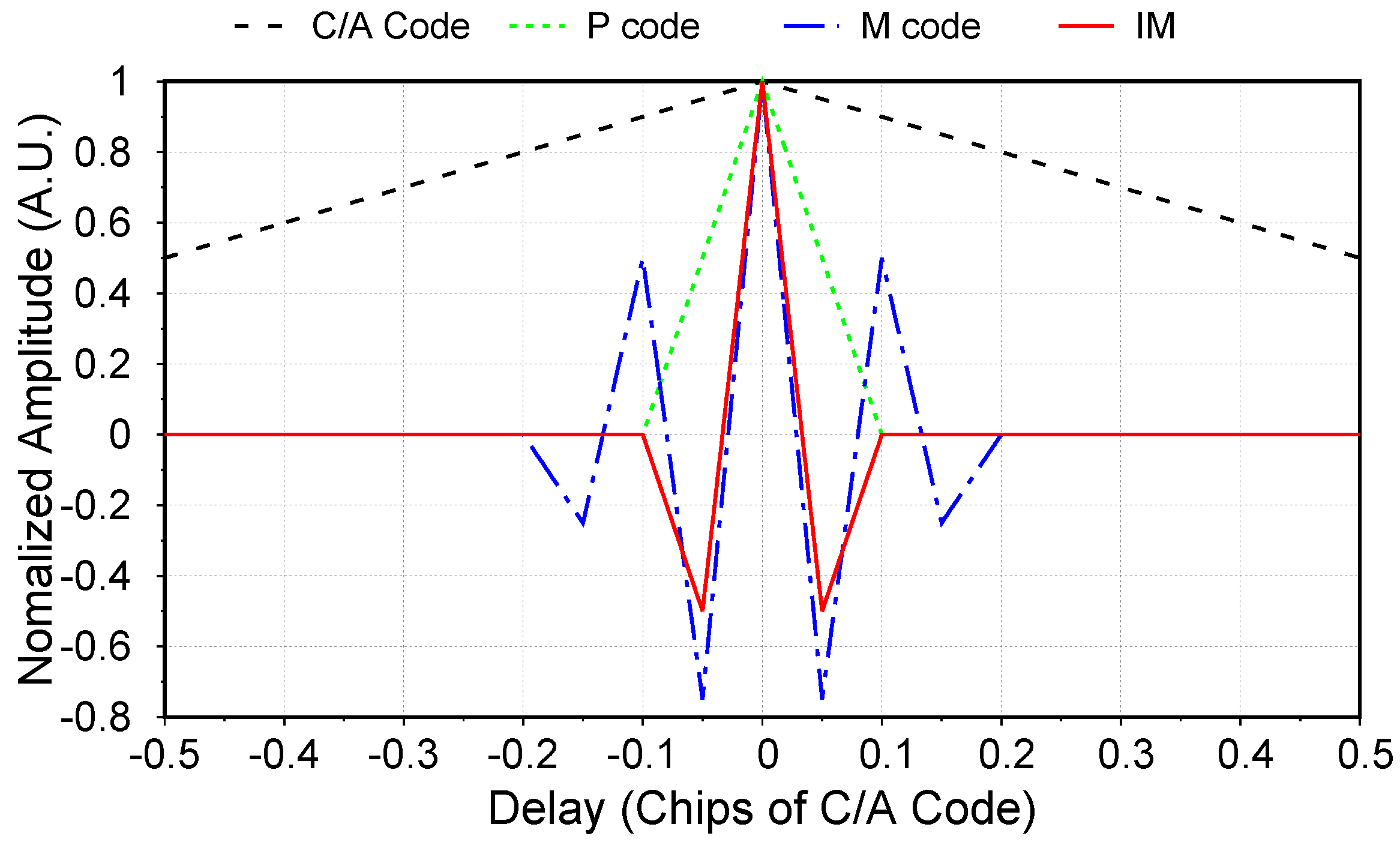

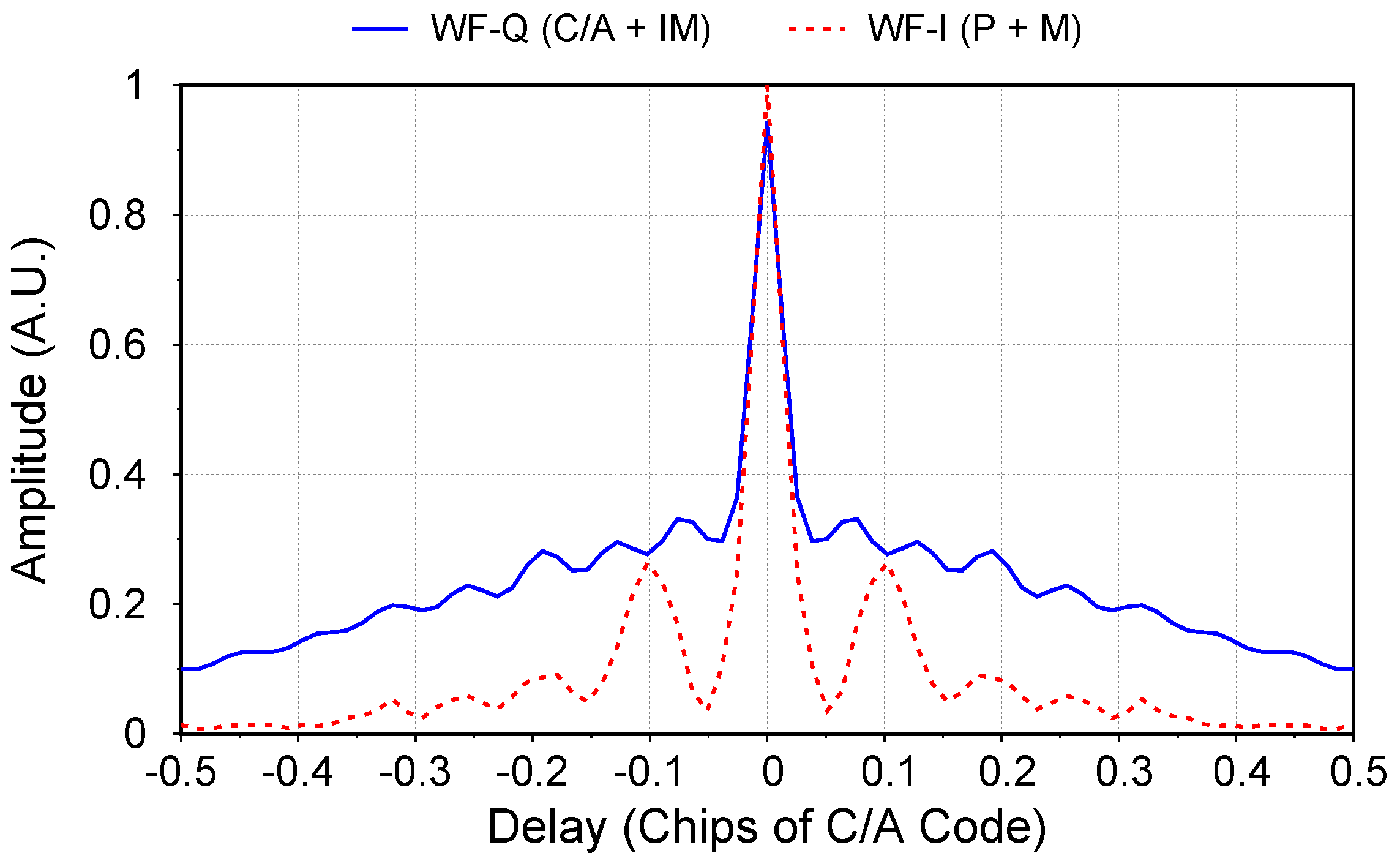
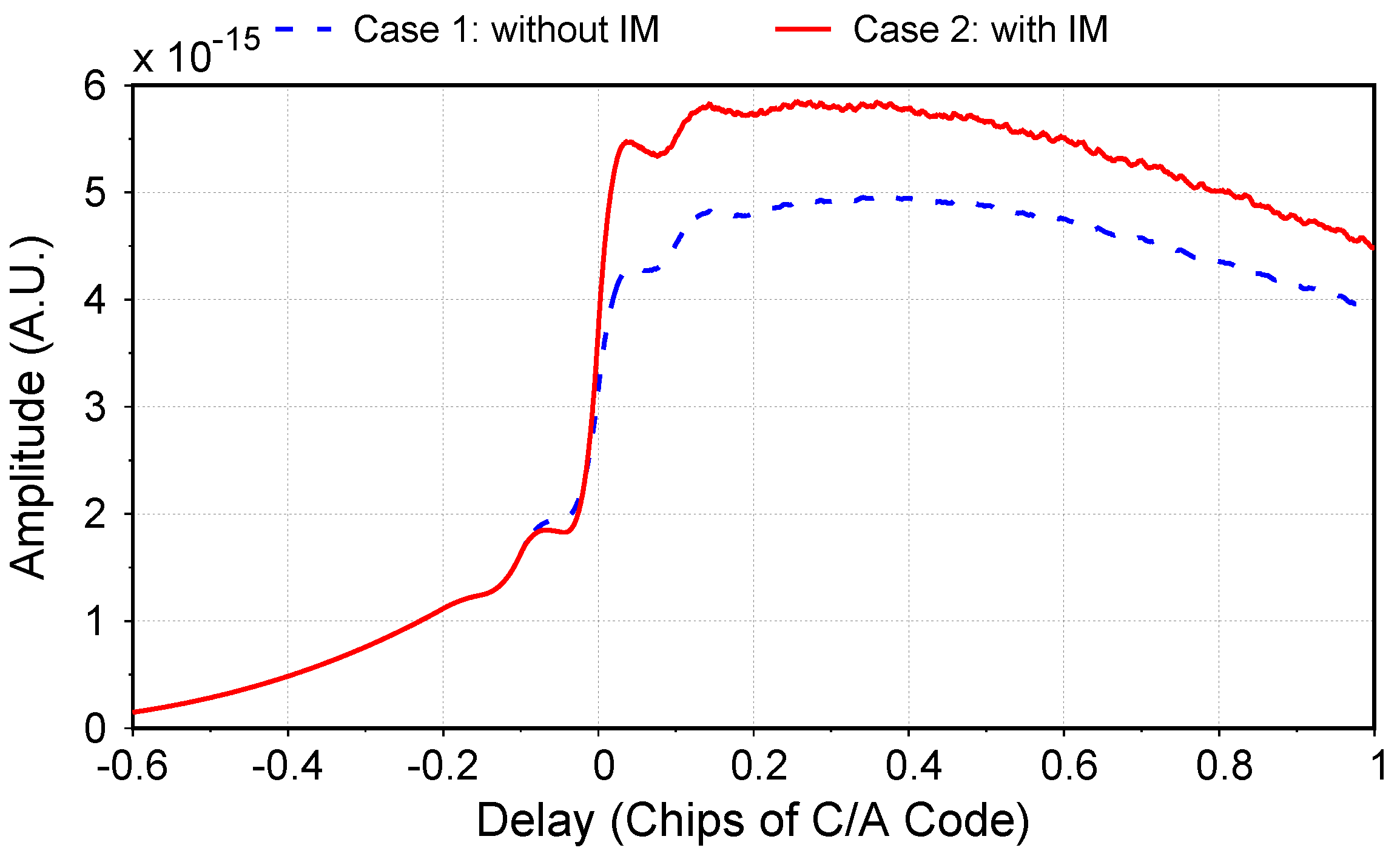
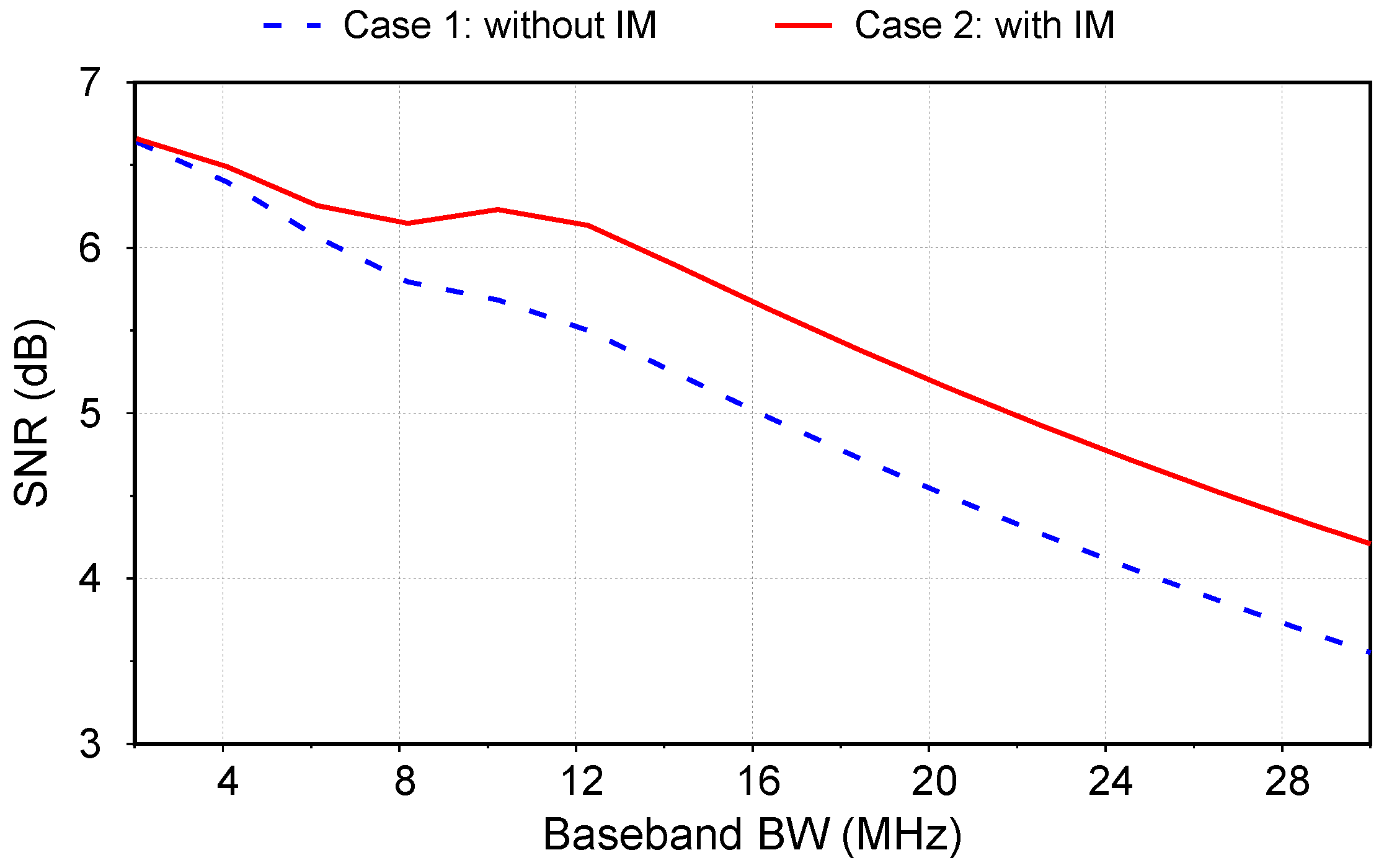

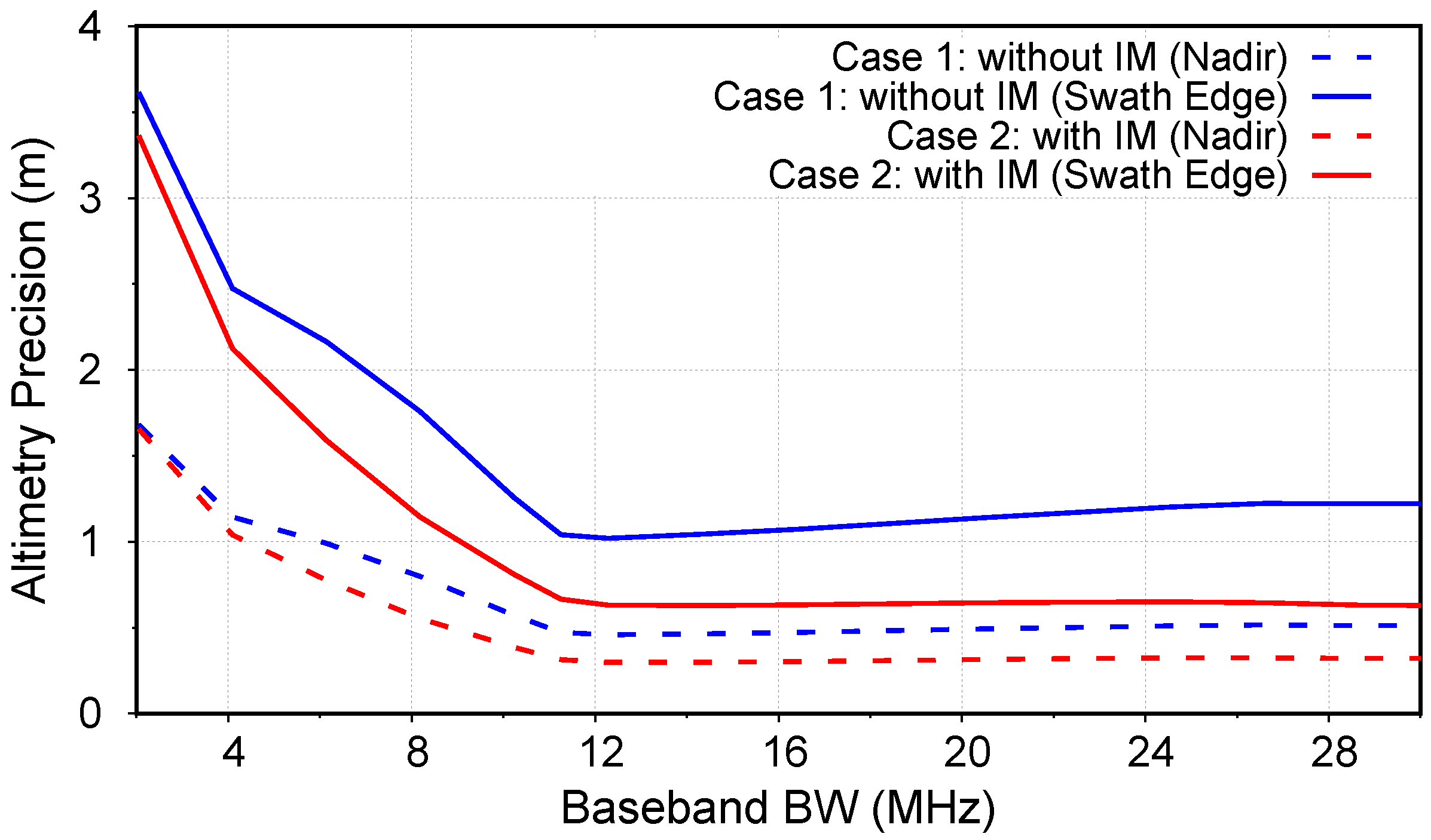
| Signal | Carrier Phase | Modulation | Percentage of Power |
|---|---|---|---|
| C/A code | Q | BPSK(1) | 25% |
| P code | I | BPSK(10) | 18.75% |
| M code | I | BOC(10, 5) | 31.25% |
| IM | Q | BOC(10, 10) | 25% |
| Parameter | Value | Unit | ||
|---|---|---|---|---|
| Orbit Altitude | 600 | Km | ||
| Incidence Angle at the SP | 15 | deg | ||
| Wind Speed at 10 m (U10) | 7 | m/s | ||
| Antenna Directivity at Nadir | 22.6 | dB | ||
| Receiver Bandwidth | 12 | MHz | ||
| Coherent Integration Time | 1 | ms |
| (s) | 1 | 5 | 10 |
|---|---|---|---|
| (m) at Nadir () | |||
| Case 1 | 0.46 | 0.21 | 0.15 |
| Case 2 | 0.30 | 0.13 | 0.10 |
| (m) at Edge of Swath () | |||
| Case 1 | 1.02 | 0.46 | 0.32 |
| Case 2 | 0.63 | 0.28 | 0.19 |
© 2016 by the authors; licensee MDPI, Basel, Switzerland. This article is an open access article distributed under the terms and conditions of the Creative Commons Attribution (CC-BY) license (http://creativecommons.org/licenses/by/4.0/).
Share and Cite
Li, W.; Rius, A.; Fabra, F.; Martín-Neira, M.; Cardellach, E.; Ribó, S.; Yang, D. The Impact of Inter-Modulation Components on Interferometric GNSS-Reflectometry. Remote Sens. 2016, 8, 1013. https://doi.org/10.3390/rs8121013
Li W, Rius A, Fabra F, Martín-Neira M, Cardellach E, Ribó S, Yang D. The Impact of Inter-Modulation Components on Interferometric GNSS-Reflectometry. Remote Sensing. 2016; 8(12):1013. https://doi.org/10.3390/rs8121013
Chicago/Turabian StyleLi, Weiqiang, Antonio Rius, Fran Fabra, Manuel Martín-Neira, Estel Cardellach, Serni Ribó, and Dongkai Yang. 2016. "The Impact of Inter-Modulation Components on Interferometric GNSS-Reflectometry" Remote Sensing 8, no. 12: 1013. https://doi.org/10.3390/rs8121013






